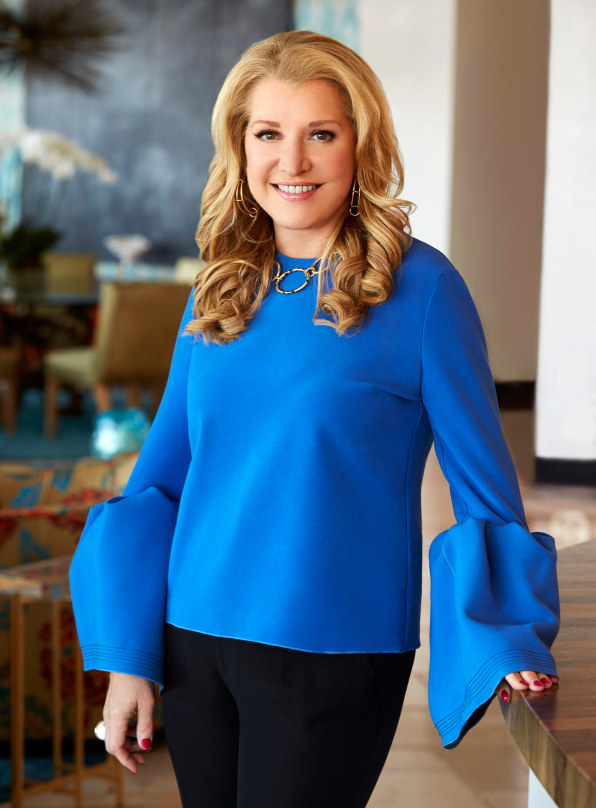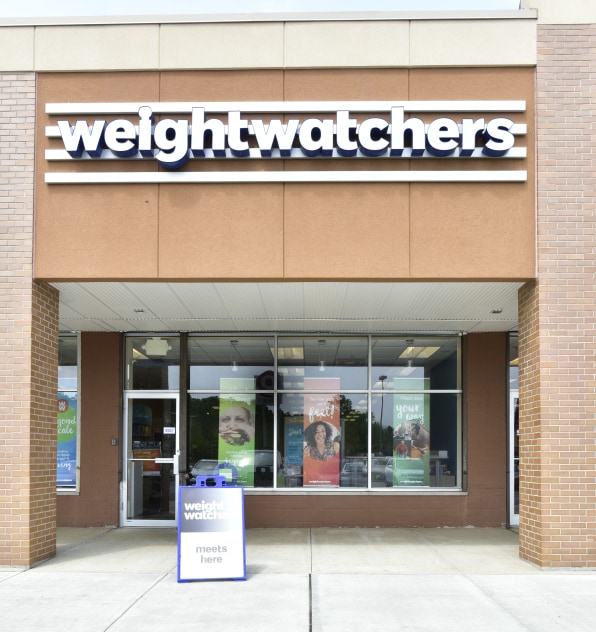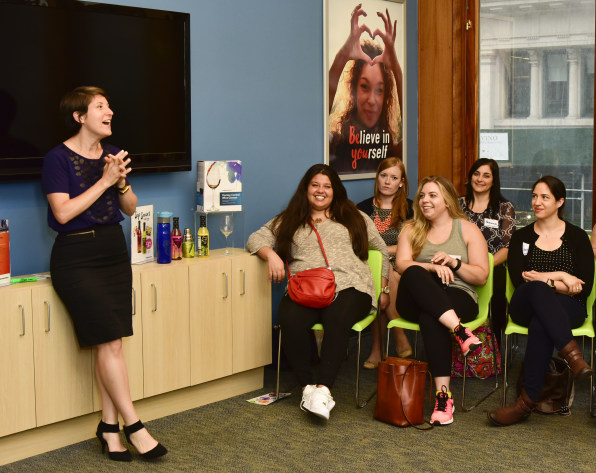Weight Watchers Brand
Mindy Grossman was only 14 years old when she was first introduced to Weight Watchers. At the time, she was a chubby Long Island teen who had one dream: to make the cheerleading team. But for that, she'd need to lose 10 pounds.
Her mother, who struggled with the scale her entire life, took her to a local Weight Watchers meeting. There, the staff weighed the young Grossman, asked her to monitor her daily calorie intake, and encouraged her week after week to keep at it.
"I was able to try out for the team—and I made it," Grossman recalls with pride, all these years later. "Part of it was losing the weight, but part of it was the confidence [Weight Watchers] gave me."

Grossman kept that touch point—namely, what she describes as "the human emotion behind the brand"—when she took on the position of president and CEO of Weight Watchers International, Inc., in July this year. Her goal was to protect the company's legacy of a community support system, while ushering in a new era that would better appeal to new consumers who see weight as part of a larger picture.
In fact, upon accepting her new position,Grossman says that colleagues and friends kept asking her the same two questions: Are you going to change the name of the company? And will you keep the physical weekly meetings?
"I said, 'You're asking the wrong questions,'" Grossman tells Fast Company. Instead, she countered: What does the brand stand for? And what is the future articulation of the brand?
Weight Watchers, she reminded new employees and friends, comes with 54 years of history. American consumers view the weight loss brand as a credible, scientific company that delivers on its fuss-free promises. But at the same time, it's considered old-fashioned, one many associate as "their mother's" diet program. Not to mention, society moved beyond purely restricting calories—it's now all about health, wellness, and $30 yoga classes.
Related: DNA-Based Diet Advice Is Big Business With Little Scientific Support
Weight Watchers now competes against a host of companies, from weight loss apps like Lose It!, to fitness trackers like Fitbit, to fitness classes that have morphed into lifestyles like SoulCycle. As such, the iconic brand is on a mission to move toward a more holistic approach, while simultaneously convincing the public (and younger consumers) to look at them in a new light. This touches a multitude of products, including meetings, events, and content.
"It's not just about weight anymore," stresses Grossman. "People aspire to have the best life they have the way they can live it . . . Today, [consumers] want a lifestyle."

Catering To A New Generation
The start of a new calendar year is typically Weight Watchers' highest-performing period—a time that delivers the most sign-ups by those eager to jumpstart their New Year's resolutions. But in January 2015, subscribers declined 20% year-over-year to 2.9 million, from 3.6 million in the first quarter of 2014. Deb Benovitz, senior vice president, global insights for Weight Watchers, quickly commissioned an investigative survey into the sudden drop.
The results were surprising. The unifying consumer response, as Benovitz recalls, was: "'You are a diet brand, and frankly, we are no longer willing to diet. We are seeking something that fits with our life.'"
Ironically, one of Weight Watchers' biggest selling points—and one that gave way to decades of success—was its unrestrictive, flexible approach to eating. Members are not commanded to eat certain foods, curb intake at certain hours, or simply consist on cabbage soup. Weight Watchers assigns foods specific points that one can eat a total of per day. That means you're not deprived of pizza, burgers, or pies, provided they're leveled out with lower-point (healthier/lower calorie) items. It was successful in part because unlike most diets, it didn't interfere with one's social life: There was no need to extricate yourself from family dinners or nights out.
Related: Cell Massages To Cryotherapy: Inside The "Biohacking" Gym Of The Future
But what the brand heard, loud and clear, was that the term "diet" was rife with negative connotations. It's a word that feels more reactive than proactive, and screams failure should they ever fall off course.
"If I look at my mother's generation, people would fix things that were broken," says Grossman. "Today's generation is more preventative; they want to live healthily. They want to educate themselves."
Members reported that even the language in weekly meetings was problematic, saying, "'Support is for weak people,'" reports Benovitz. "We are strong. We are warriors. What we want is inspiration—inspiration to keep this going . . . We want normalization.'"
What Weight Watchers found was that consumers wanted, more or less, a lifestyle brand. They want to eat better, move more, and feel zen about the entire process. They also wanted to do this all within a strong community that's both modern and accessible. And they'll spend money on it: Consumers (29% of millennials and 26% of gen X) are increasingly willing to pay more for foods and products that possess health benefits, according to a recent Nielsen report. Meanwhile, healthy categories within food, beverage, and personal care grew 7% over the last few years.
Benovitz says that consumers liked a lot of things about their program (like how easily it fit into their lifestyle), they just wanted it packaged in a new way. "We realized that if we talked about [Weight Watchers] differently and we upped certain things and played down other things, we would really be giving people pretty close to what they wanted," she explains.

Farewell To The Diet
In 2015, Weight Watchers got to work shedding its old-fashioned image while beefing up what members appreciated most, which includes, among other things, Oprah Winfrey. The beloved celebrity signed on as a spokesperson and bought a 10% stake in the company, prompting a significant stock boost.
Shortly thereafter, the brand revealed its Beyond the Scale program, which brought its new "livable" philosophy to two more sectors: fitness and mind-set. It's an interconnected approach that incorporates equal amounts of movement, happiness, and meditation to one's weight loss goal. And instead of pure calorie counting, members were encouraged to pursue healthier eating choices with the new SmartPoints system, which focuses on lean protein, fruits, and vegetables while translating mind-bogglingly complex nutritional information into simple numbers assigned a value based on calories, saturated fat, sugar, and protein.
Their program is also affordable compared to other diets, such as NutriSystem ($298 for four weeks). The average monthly cost of a standard Weight Watchers membership, which includes unlimited monthly meetings and digital tools, is $44.95.
In 2015, Weight Watchers also launched what they hoped would be millennial bait: a digital community, called Connect, where for $19.95, members swap healthy living tips, recipes, and nudge one another to keep at it. (It looks a lot like Instagram, but with far more motivational quotes and pictures of Greek yogurt.) Instead of age or location, the community is gathered together by life stages: brides getting svelte for their weddings, retirees with more time on their hands, or new moms. Each member sets personalized goals that they work toward by tracking exercise, meals, and snacks.
"Where we do best for our members is where we intersect the area between science and consumer insights," says Gary Foster, PhD, chief scientific officer at Weight Watchers International, Inc.
Even the physical meetings received a nip and tuck. In years past, Weight Watchers staff weighed attendees and assigned them a weight loss goal. Now, the members dictate to the staff how much they want to lose, along with other life goals they hope to achieve. Some are weight-related—like sitting in an airplane without a seat extender—though many are psychological, such as "I want more confidence" or "I want to feel better about myself," says Benovitz.
In this era, physical interaction is a chief goal, especially in the age of "experiential" consumerism. A study by the Harris Group found that 72% of millennials prefer to spend money on experiences rather than material objects. And seeing how wellness travel is now a $563 billion global industry, and growing at double the rate of general travel sectors, Weight Watchers announced a host of experiences, such as wellness festivals, cruises, and other community-centered events.
Weight Watchers took the new strategy one step further, tweaking the logo—and even its name. The brand now goes by the abbreviated WW, a mark that harkens to its founding theme without directly reminding the public of its diet origins. The stacked WW in an orange coin logo is identifiable without alienating the consumer. (Although the logo was first introduced in 2012, it's become more prominently used in branded materials since the introduction of Beyond The Scale.)
For the last few years, Weight Watchers' core demographic has been 90% female, with an average age of 38. In the last year, however, they are experiencing growth in a younger demographic, such as women in their 20s and 30s.
"We need to be surprising yet familiar," explains Grossman, noting that while she wants to attract millennials, the product still needs to appeal to baby boomers.

"Livability On Steroids"
So far, the changes have paid off. Revenue increased by 14% since last November to $324 million, and Weight Watchers saw its eighth consecutive quarter of member recruitment growth. It now boasts 1.3 million meeting members (an 11% year-over-year increase) and 2 million digital subscribers. Each month, over 1 million members visit Connect.
This month, Weight Watchers improves on its original SmartPoints program by launching an even more flexible program called WW Freestyle. It resembles its predecessor, but appoints zero points to 200 more foods, in addition to fruits and vegetables–none of these items need to be tracked. This includes turkey breast, seafood, corn, lentils, eggs, and peas. In addition, there are now "rollover points" in case one doesn't hit the daily allowance. Benovitz describes the latest program update as "livability on steroids."
"I've become obsessed with the word livable," says Grossman. "People want very simple things that fit into their life and social life."
So could one, in essence, consume an entire carton of fruit each day? Foster, who tested the new program for the last year, says zero-point foods propel members to add more nutritious items to their diet, with less time spent tracking–and very little risk factor.
"We've picked foods that are at low risk for overconsumption," explains Foster, adding, "very few people come to Weight Watchers saying, 'I really have a problem with strawberries.'"
Shaping Up For The Future
Weight Watchers concedes that dipping into the lifestyle market positions them in the same territory as countless fitness and food brands, including South Beach Diet and Diet.com, which delved into the sector years ago. Still, claims Grossman, their chief competitor remains people thinking they can do this themselves.
"People find that they need structure, tools, and support to be successful," she says. "They need a community."
Weight Watchers currently hosts 15,000 weekly meetings in the U.S. and 32,000 globally. They're held everywhere, from big, dense cities to remote locations in sparsely populated states like Wyoming.
Moving forward, the company wants to rapidly expand across the U.S., especially in the low-income communities often ignored in the health and wellness space. The plan is to aggressively partner with more community centers to bring their tools to the places that need it most. Approximately two-thirds of Americans are considered to be overweight or obese, and 80% do not meet the recommended amount of physical exercise, reports the Centers for Disease Control and Prevention.
Grossman considers Weight Watchers an "aspirationally accessible brand" with programs and platforms that can span across a diverse subset, no matter what the income, race, or locale.
"I've met billionaires who are on Weight Watchers, and I've met people on food stamps that were on Weight Watchers," says Grossman. "Wellness needs to be much more democratized and serve that many more people if we're really going to help solve the crisis that we're in right now."
Weight Watchers' mission is a bold one, and one that hasn't been this publicly addressed since Michelle Obama's Let's Move! campaign. The wellness scene, with all its attention to crystal healing, pricey food delivery startups, or boutique fitness classes, is often criticized for primarily catering to high-income women. As New York magazine declared, wellness is the new luxury lifestyle.
"We are the brand that can bring health and wellness to everyone, and not just a certain few," declares Grossman.
There are other opportunities for expansion, says Grossman. Currently, women make up the majority of members, making men a larger moving target. And while most Weight Watchers products involve food—including frozen dinners and a grocery store food-points scanner—the company will move into connected categories like kitchen and home. There's also "a tremendous need and opportunity" to expand their health solutions business both in the health and corporate space, says Grossman. "There's no lack of opportunities between those."
Weight Watchers is officially in a new era, one in which it sees itself becoming the brand that can boost Americans' health while also giving it a taste of that wellness lifestyle it very much aspires to. With that, expect everyone from Oprah to social media influencers asking you to "move beyond the scale"–but with food points as social currency. For Grossman, the challenge lies in how to be a brand that can work with a lot of different constituencies without turning off your retired mom.
"You can't say, 'I'm starting a movement,' it doesn't work," says Grossman. "You have to build something, and it builds upon itself and then becomes one, and that's what I hope we can do."
Source: https://www.fastcompany.com/40500280/how-weight-watchers-transformed-itself-into-a-lifestyle-brand








Tidak ada komentar:
Posting Komentar